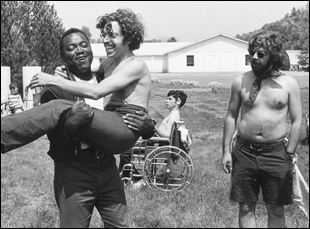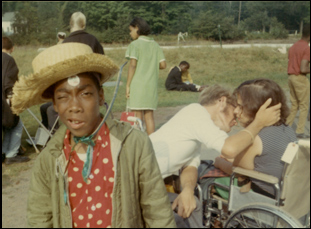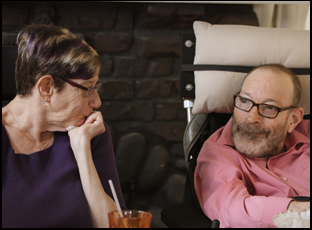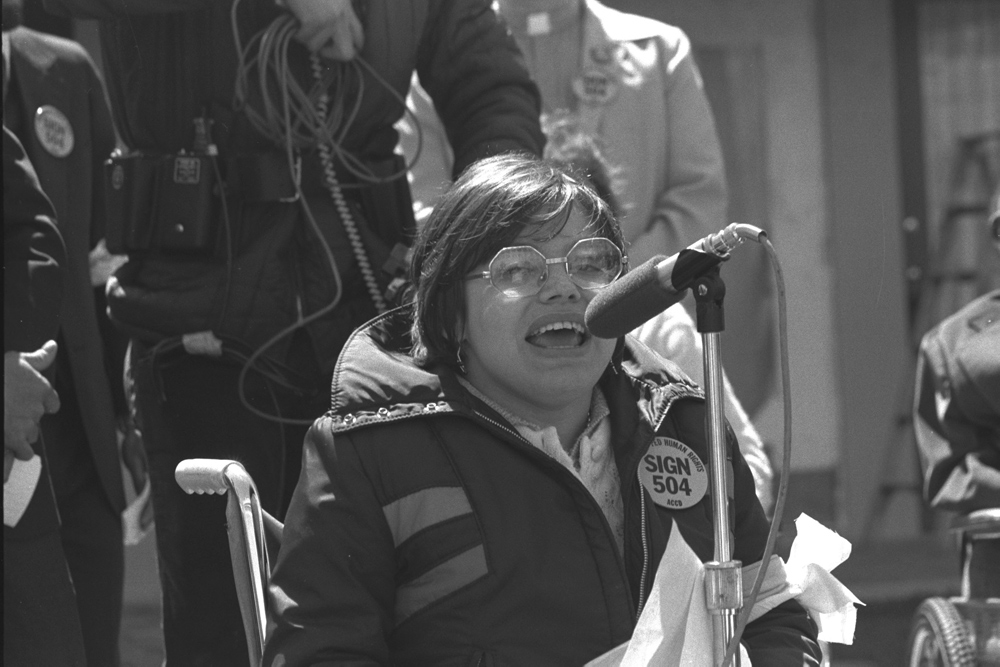Nicole Newnham and Jim LeBrecht had been longtime collaborators well before co-directing their first film together, with Newnham, the documentarian behind such films as “The Revolutionary Optimists” (with Maren Grainger-Monsen) and “The Rape of Europa” (with Richard Berge and Bonni Cohen) knowing that if she wanted her sound mix done right, she’d make the sojourn to LeBrecht’s Berkeley Sound Artists. LeBrecht, himself, had ended up in the Bay Area after following his drweam of trailing the Grateful Dead on tour where he developed sharp auditory senses, and while Newnham knew some of this, it wasn’t until asking LeBrecht about what his own dream movie project would be that she learned of his time in upstate New York at Camp Jened, a summer retreat for kids with disabilities.
LeBrecht, who was born with spina bifida, wondered why no one had ever told the story of this unique camp run by hippies in the early 1970s and knew it could be massively entertaining when the activities there were no different than anywhere else populated by hormonally-charged teens largely left without parental supervision. But what he would soon find together with Newnham, combing over old pictures and film footage captured by the People’s Video Theater (a filmmaker coalition that visited the camp with Portapaks and gave some of the campers their own cameras), was a story bigger than either could imagine when the confidence instilled at the camp where the kids felt free to be themselves, completely disassociated from the physical ailment they were often defined by in the outside world, manifested itself into a passion for activism, ultimately culminating in the passage of the Americans with Disabilities Act in 1990, ensuring that streets and buildings would be accessible to everyone.
“Crip Camp: A Disability Revolution,” which is now streaming on Netflix, connects the dots in a way that only LeBrecht and Newnham likely could, pairing the latter’s experience in documenting large-scale movements that have sought social justice with LeBrecht’s warm, intimate recollections of what a formative time he and his fellow campers had at Camp Jened. In sharing his story, LeBrecht is able to introduce audiences to a number of his remarkable friends from the old days, including Denise and Neil Jacobson, a couple that found they had far more in common than living with cerebral palsy, and Judy Heumann, who would waste no time parlaying the spirit of community she felt at Jened into Disabled in Action, an activist group which rallied around the need for stronger civil rights protections for those living with disabilities.
At a time when they were hardly alone in seeking equal rights under the law, “Crip Camp” becomes galvanizing in illustrating the intersectionality between the civil rights movement, the women’s rights movement and the disabled community’s strides towards changing the world for the better and LeBrecht and Newnham find a flashpoint in the 504 Sit-In, a 28-day protest Heumann was central in organizing in the San Francisco office of U.S. secretary of Health, Education and Welfare Joseph Califano, who had failed to sign off on the anti-discriminatory Rehabilitation Act of 1973 after it had been passed in Congress. Vividly capturing the era, “Crip Camp” feels urgent now and after a rousing reception at Sundance, where it won the audience award, and True/False earlier this month, it recently premiered on Netflix as the second film to be released under Barack and Michelle Obama’s Higher Ground production banner and LeBrecht and Newnham reflected on the film striking a chord with crowds around the country, the collaboration that yielded such a sensitive and insightful documentary and how they were able to amass so much actual footage from when this lesser-known piece of history unfolded.

Jim LeBrecht: Well, it’s been nothing like I’ve experienced in my life. And just been really getting the reception of the film the way it has been beyond one’s wildest dreams to be really honest. Nicole, you’ve done a lot of travel with a ton of films…
Nicole Newnham: I have, and this one is really, really special. All film [releases] are special but Jim and I really both carried the sense into the Sundance premiere that this was a historic moment to bring this story out in the world with these amazing activists and folks who were pioneers of the disability movement and community as we know it today, and really haven’t been seen or understood the way that they should be. To bring it out to Sundance with the Obamas on board was frankly a little surreal, and we had eight or nine folks from the film and then to see people on Main Street in Park City come up to them and start talking to them and just the joy with which the audience embraced the story and the film was really spectacular.
Jim, had you kept in touch with a lot of the people you went to camp with or was making this like a big reunion?
Jim LeBrecht: I’d lost touch with a lot of folks, but I would see Neil [Jacobson] and Denise [Sherer Jacobson] around in the community once in a while, and Judy and I had been reconnecting a little bit before we started work on the film. But it certainly has brought us all a lot closer. I hadn’t talked with Lionel [Je’ Woodyard, one of the Camp Jened counselors] for quite a very long time, and how often do you get a chance to really connect deeply with people from your summer camp years ago who were wonderful friends that through the course of time you drifted off in different directions? I was really excited to reconnect with people like Lionel.
Was there any moment either during the research of this or the interviews that changed your ideas of what this could be?
Nicole Newnham: We didn’t anticipate was that we really were going to be able to follow Jened campers and that particular group of friends, not just through interviews but in actual archival footage all the way through to the 504 victory in the ADA. We knew that Judy Heumann traced across all of that and that there was footage of her, but it was really an amazing process of discovery to be watching the footage of some march in Washington, DC, and go, “There’s Neil and Denise from camp.” And “There’s Nancy [Rosenblum], Jim’s first girlfriend.” And Jim’s like, “Yeah, I know that’s Nancy because the armrests on the wheelchair were exactly that height.”
Jim LeBrecht: And as it started to unfold, and Nicole and I started doing interviews, the discussions that we were having and the honesty [about what happened] and really the stories that I had never heard, it became apparent that there was so much meat on the bone on the story that it’s going to be incredibly rich.
Nicole Newnham: We tried to bring that feeling of the joy of discovery of “There’s my old camp friends — they did that too” into the making of the film so that this really feels a little bit that way. They fall in love with this group of friends [like Jim] and then they get the joy of going, “My God, they did that?” And then you get to the end and it’s like, “There’s curb cuts.” Those curb cuts that you take advantage of every time you roll your suitcase down a sidewalk, they played a role in doing that.

Nicole Newnham: Yeah, we did our research and we had some amazing researchers on our team — our associate producer, Lauren Schwartzman, was really fierce and we had two archival producers [Jennifer Petrucelli and Rachel Antell] that have a company called Sub-Basement Archival, on the case as well. For example, somebody would hear we were doing the film and say, “I have this DVD of MacNeil/Lehrer [Report], a program that I teach at one point in my research, and maybe you’d be interested in that.” In several cases, there were bootleg versions of things like that we ended up going back and getting the rights for, but the actual archive didn’t exist.
That one case [specifically] we gave the footage of MacNeil/Lehrer program back to PBS, who didn’t happen to have that particular show in their archive anymore. Unfortunately, Evan White, the journalist who followed the 504 [Sit-in in San Francisco], the archive of his footage was burned at some point during history, so we wanted to recreate the footage that he had captured and the sense of him joining them and being this fierce ally in the fight for the 504, so we had to find little fragments of his footage that existed on beta SP tapes and old file boxes from other films that had been made throughout history where mainly they had used a shot or two of his, and then collage it back together like pottery shards to try to create these immersive scenes that would feel continuous.
Is there any way that the production had to be sensitive to issues of disability, such as filming interviews in a certain way?
Jim LeBrecht: Nicole, I was going to make a statement — I want to see if you agree with you or not, but I think especially with our interviews, we really did not think about showing the wheelchair or a person’s disability that it wasn’t like let’s introduce this after a moment. We just basically just edited things the way that just really felt natural.
Nicole Newnham: Yeah, that’s true. We didn’t want to do studio interviews or something, and we definitely didn’t want these broad frames that you sometimes see that suggest, look, here’s a person in a wheelchair. But we also chose to just try to keep the interviews as natural and environmental as the people’s video theater footage. We actually worked with a DP who shoots with a camera on his shoulder, which lots of people don’t do anymore because they’re used to these smaller cameras that are on braces or that are held out in front of you, and we wanted that feeling of a little bit of continuity when it came to the modern day scenes to blend in with that verite feeling.
And I would agree with Jim. Corbett O’Toole, who’s this extraordinary activist who’s in the film and a friend of Jim’s, said [during her interview], “This is really nice. It was really nice to be interviewed by a director who had a disability who wasn’t going to ask her to put her shoes on and get out of bed on camera.” A little bit othering that often goes on when we non-disabled people try to show or present people with disabilities and how they live. That was what was so wonderful about working with Jim is that that’s not the way you’re looking at the world.

Nicole Newnham: Yeah, that was something we experimented with a lot actually with our editors and with each other, because what we found is a standard subtitle treatment with the folks who have cerebral palsy and speech impediments was frustrating because often the sentence would come up on the screen and then the punchline of the joke or the thing that they were saying would happen in their voice five or six seconds later and we wanted people to experience the way that our characters were speaking in real time. We also felt like the way those particular characters spoke was very poetic and powerful and we wanted to honor that. It was actually Lauren Schwartzman, our associate producer, who started playing around with something that looks a little bit more like beat poetry, moving the placement around so that your eye didn’t have to always go down to the bottom of the screen, but that’s lifted up so that you’re able to see what we think was the most important thing in the frame more easily. That’s how that evolved.
It was exciting to see following the film’s second screening at Sundance, which was in Salt Lake City, a panel discussion that gave a platform as much to the local disabled community as to the film. Has that been an exciting opportunity for this?
Jim LeBrecht: Yeah, it’s also introducing a large audience to some of the local people in their communities and everybody that we met, either at Sundance or at True/False were wonderful people that neither one of us had met before, so it was a two-way street there on that.
Nicole Newnham: Yeah. That’s been really great that the film is one in which local disability activists feel like after the film they can stand up and talk about the things that still aren’t right in the Q & As, the access they still need, the justice that is still being sought, which makes us really, really happy. There was actually another screening in Salt Lake City where local governmental officials invited some of their constituents with disabilities to come and one local politician said that the film and the conversation after it had inspired him to take another look at efforts to create accessible transportation. People will often say, “Can a documentary film create change?” And I think the answer is no, not by itself. But I think a powerful story in partnership with the activists on the ground who, if you’ve seen the film, are really the people who always are the ones who make change happen, that can be a really powerful combination.
“Crip Camp” is now streaming on Netflix.




